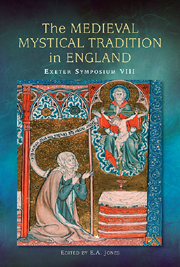 The Medieval Mystical Tradition in England
The Medieval Mystical Tradition in England Published online by Cambridge University Press: 05 July 2013
Often internalising wider cultural concerns and anxieties, asceticism is a phenomenon enacted on the body with the intent of altering the mind. Yet while it is a practice almost universal in application, it is somewhat elusive in definition. Not all self-inflicted pain is ascetic. What some cultures perceive as exceptional behaviour others consider necessary rites of passage. Harm can be inflicted through inspiration from gods or from demons, through sanctity or madness; it can be moderate or extreme. Nevertheless, while different societies have different conceptions and expectations of the body and its rituals, none accepts it in an unmodified state and none views it as unconnected to higher cultural and spiritual concerns. Emile Durkheim writes that:
The pure ascetic is a man who raises himself above men and acquires a special sanctity by fasts and vigils, by retreat and silence, or in a word, by privations, rather than by acts of positive piety (offerings, sacrifices, prayers, etc.).
Durkheim's definition makes two important observations, firstly, that asceticism differs from popular forms of piety, and secondly, that the ascetic has not achieved perfection, but is engaged, through negation, in the transformation of both his spiritual and corporeal capacities. Indeed, modern conceptions of ascesis have elevated it to a notable position in cultural theory, especially in terms of societal structures, discipline and identity. Gavin Flood adds a further dimension to the definition offered by Durkheim which demonstrates the power of asceticism to define not only individuals but wider cultural identities.
To save this book to your Kindle, first ensure [email protected] is added to your Approved Personal Document E-mail List under your Personal Document Settings on the Manage Your Content and Devices page of your Amazon account. Then enter the ‘name’ part of your Kindle email address below. Find out more about saving to your Kindle.
Note you can select to save to either the @free.kindle.com or @kindle.com variations. ‘@free.kindle.com’ emails are free but can only be saved to your device when it is connected to wi-fi. ‘@kindle.com’ emails can be delivered even when you are not connected to wi-fi, but note that service fees apply.
Find out more about the Kindle Personal Document Service.
To save content items to your account, please confirm that you agree to abide by our usage policies. If this is the first time you use this feature, you will be asked to authorise Cambridge Core to connect with your account. Find out more about saving content to Dropbox.
To save content items to your account, please confirm that you agree to abide by our usage policies. If this is the first time you use this feature, you will be asked to authorise Cambridge Core to connect with your account. Find out more about saving content to Google Drive.